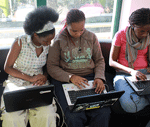New study confirms that gender equity and development go hand-in-hand
Published on Thu, 2012-08-30 08:35
“Improving gender equity in itself may be a goal with clear, intrinsic value. However, a substantial body of research now suggests that gender equity and the achievement of other development goals, such as health, education, social and economic rights fulfillment, and even growth, are inseparable,” wrote expert Terra Lawson-Remer, of the Council on Foreign Relations (CFR), based on several statistical studies, including the Gender Equity Index issued by Social Watch. “A careful look at the data reveals that societies with greater gender equality achieve higher levels of social and economic rights fulfillment for all members,” observed Lawson-Remer in an article published at the Development Channel web site of the CFR, an US based independent and nonpartisan civic organization and think tank. Lawson-Remer, fellow for civil society, markets and democracy at the CFR, remarked that “higher levels of female education and literacy have been found to reduce child mortality and improve educational outcomes for the next generation.” “The presence of women in political leadership positions appears to increase schooling for girls. Children’s health is influenced by women’s bargaining power in the home. Lower fertility rates, also associated with increased educational attainment for women, can have a positive effect on growth, while gender inequality in education undermines growth,” wrote the expert, who is also co-founder and co-director of the Economic and Social Rights Empowerment Initiative that produces the Index of Social & Economic Rights Fulfillment (SERF). The statistical studies mentioned by Lawson-Remer – the UNDP’s Gender Inequality Index (GII), Social Watch’s Gender Equity Index (GEI) and the SERF – confirm the links between gender equality and general development. In her article, Lawson-Remer remarked that the Human Development Index (HDI) produced by the UNDP (UN Development Programme) “finds a broad correlation between gender inequality and human development outcomes, with low-ranking countries […] in general performing much more poorly on gender inequality measurements than high-HDI countries.” “In my own recent research [on the SERF Index] as well as a book forthcoming from Oxford University Press this winter, my colleagues and I find a strong correlation between gender equality and economic and social rights fulfillment,” she added. Crossing data The expert corroborated that conclusion crossing data from the SERF Index and Social Watch’s GEI for a sample of 93 countries, and from the SERF Index and UNDP’s GII for 84 countries. The SERF Index measures the fulfillment of economic and social rights to food, to adequate shelter, to healthcare, to education, to decent work and to social security, and the protection against discrimination. The GEI measures the gap between women and men in education, the economy and political empowerment. The GII reflects women’s disadvantage in three dimensions –reproductive health, empowerment and the labor market “The correlation between gender equity and social and economic rights fulfillment can also be observed on the regional level, with the notable exception of the Middle East and North Africa, where social and economic rights fulfillment is relatively high but gender equality is low. There is also a sizable gap in South Asia,” Lawson-Remer noted. “The relationship between gender inequality and development outcomes is likely not unidirectional,” she explained. “For example, there is robust evidence that gender inequality decreases as countries get richer, suggesting that economic growth could also be leading to better gender outcomes. And recent research indicates that women may be disproportionally hurt by global economic downturns: in developing countries, where women are concentrated in export manufacturing and tourism, job losses for women are greater than for men when these industries collapse.” “Taken together, however, the evidence suggests that increasing social and economic opportunities and political representation for women has ripple effects on health, education, and socio-economic outcomes throughout society and for the next generation. Gender equity and social and economic rights fulfillment go hand-in-hand,” Lawson-Remer concluded. Inequity is apparent in economy and in politics According to the updated figures of the GEI published this year by Social Watch, the achievements made by women all over the world towards equity in education are still very far from having an impact on their having a fair share in the economy or in political power. Women’s participation in the labor force is significantly less compared to men. They have substantially lower salaries for the same type of work and a higher percentage of women are employed in vulnerable or irregular jobs. But more importantly, as the GEI shows, the underachievement in economic participation and empowerment for women is verified in each of the 154 countries studied in the 2012 issue of the index. More information Source |
SUSCRIBE TO OUR NEWSLETTER



